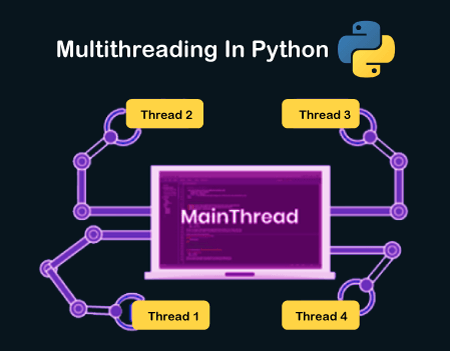Python Tutorial
Python OOPs
Python MySQL
Python MongoDB
Python SQLite
Python Questions
Plotly
Python Tkinter (GUI)
Python Web Blocker
Python MCQ
Related Tutorials
Python Programs
Multithreading in Python 3A program or process's smallest unit is called a thread, and it can run on its own or as part of a schedule set by the Operating System. Multitasking in a computer system is achieved by dividing a process into threads by an operating system. A string is a lightweight cycle that guarantees the execution of the interaction independently on the framework. When multiple processors are running on a program in Python 3, each processor runs simultaneously to carry out its own tasks.. 
Multithreading in Python 3Python MultithreadingMultithreading is a stringing procedure in Python programming to run various strings simultaneously by quickly exchanging between strings with a central processor help (called setting exchanging). In addition, it makes it possible to share its data space with the primary threads of a process, making it easier than with individual processes to share information and communicate with other threads. The goal of multithreading is to complete multiple tasks at the same time, which improves application rendering and performance. Note: The Python Global Interpreter Lock (GIL) allows running a single thread at a time, even the machine has multiple processors.Benefits of Using Python for MultithreadingThe following are the advantages of using Python for multithreading:
When to use Multithreading in Python?It is an exceptionally valuable strategy for efficient and working on the presentation of an application. Programmers can run multiple subtasks of an application at the same time by using multithreading. It lets threads talk to the same processor and share resources like files, data, and memory. In addition, it makes it easier for the user to continue running a program even when a portion of it is blocked or too long. How to achieve multithreading in Python?There are two main modules of multithreading used to handle threads in Python.
Thread modulesIt is started with Python 3, designated as obsolete, and can only be accessed with _thread that supports backward compatibility. Syntax: To implement the thread module in Python, we need to import a thread module and then define a function that performs some action by setting the target with a variable. Thread.py Output: Calculate the square root of the given number Square is: 16 Square is: 25 Square is: 36 Square is: 49 Square is: 4 Calculate the cube of the given number Cube is: 64 Cube is: 125 Cube is: 216 Cube is: 343 Cube is: 8 Total time taken by threads is: 3.005793809890747 Threading ModulesThe threading module is a high-level implementation of multithreading used to deploy an application in Python. To use multithreading, we need to import the threading module in Python Program. Thread Class Methods
Follow the given below steps to implement the threading module in Python Multithreading: 1. Import the threading module Create a new thread by importing the threading module, as shown. Syntax: A threading module is made up of a Thread class, which is instantiated to create a Python thread. 2. Declaration of the thread parameters: It contains the target function, argument, and kwargs as the parameter in the Thread() class.
For example: In the above code, we invoked the print_hello() function as the target parameter. The print_hello() contains one parameter n, which passed to the args parameter. 3. Start a new thread: To start a thread in Python multithreading, call the thread class's object. The start() method can be called once for each thread object; otherwise, it throws an exception error. Syntax: 4. Join method: It is a join() method used in the thread class to halt the main thread's execution and waits till the complete execution of the thread object. When the thread object is completed, it starts the execution of the main thread in Python. Joinmethod.py Output: Hello, how old are you? 20 Thank you The join() method stops the main thread from running when the above program is run and waits until the thread t1 has finished running. The main thread begins its execution once the t1 has completed successfully. Note: If we do not use the join() method, the interpreter can execute any print statement inside the Python program. Generally, it executes the first print statement because the interpreter executes the lines of codes from the program's start.5. Synchronizing Threads in Python It is a thread synchronization mechanism that makes sure that no two threads can run the same part of the program at the same time to access shared resources. Critical sections could be used to describe the situation. To avoid the critical section condition, in which two threads cannot simultaneously access resources, we employ a race condition. Let's write a program to use the threading module in Python Multithreading. Threading.py Output: Calculate the square root of the given number Calculate the cube of the given number Square is: 16 Cube is: 64 Square is: 25 Cube is: 125 Square is: 36 Cube is: 216 Square is: 49 Cube is: 343 Square is: 4 Cube is: 8 Total time taken by threads is: 1.5140972137451172 Again executing the main thread Thread 1 and Thread 2 have finished their execution.
Next TopicStatic in Python
|
 For Videos Join Our Youtube Channel: Join Now
For Videos Join Our Youtube Channel: Join Now
Feedback
- Send your Feedback to [email protected]
Help Others, Please Share










